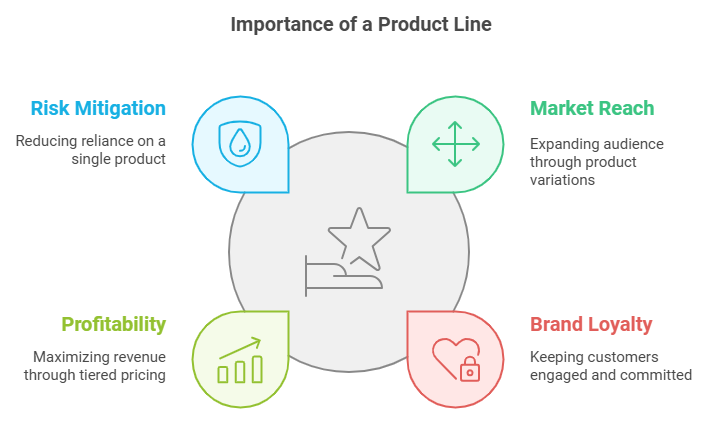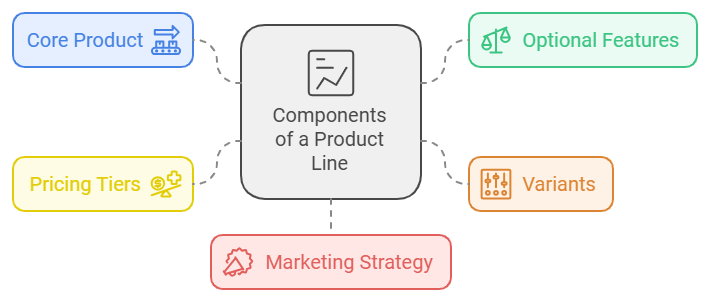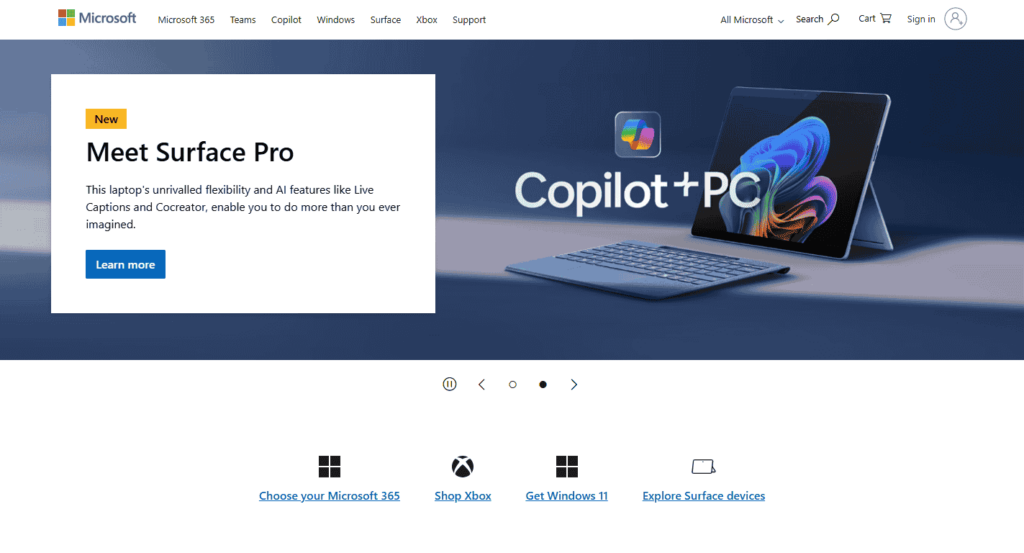If you’ve ever wondered why popular brands maintain such a loyal following, the answer lies largely in their product line strategy. When done well, it doesn’t just offer variety; it becomes a powerful tool for attracting a broader audience, building brand loyalty, and driving profit. This guide dives deep into the concept of a product line, breaking down why it’s crucial for businesses, the types, dimensions, and components involved, and how it compares to a product mix.
Table of Contents
What is a Product Line?

At its core, a product line is a group of related products marketed under a single brand that serve similar needs or target the same audience. For example, in the smartphone industry, Apple’s iPhone series (ranging from the iPhone SE to the iPhone 16 Pro Max) is a well-known line of products. Each version shares essential characteristics and branding while offering unique variations that cater to different customer preferences and budgets.
In essence, it allows companies to diversify their offerings while maintaining a clear and cohesive brand identity. This strategy not only keeps loyal customers within the brand but also attracts new ones seeking different features or price points.
Importance of a Product Line
A well-constructed line of products has several strategic advantages. Here’s why it’s essential for any brand looking to dominate its industry:

- Increases Market Reach: By offering variations of a product, a brand can cater to different customer segments, which allows it to reach a broader audience. This approach lets a brand expand its customer base without diluting its core identity.
- Strengthens Brand Loyalty: A strong line of products keeps customers engaged with a brand as they grow and evolve. For instance, Apple users often stick to the brand not only because of individual product quality but because the product line caters to a range of needs, from entry-level to premium.
- Improves Profitability: Product lines often come with tiered pricing, which allows companies to maximize revenue from different customer demographics. High-end options attract those seeking premium features, while entry-level options make the brand accessible to a wider audience.
- Mitigates Risk: Diversifying through a product line means that a brand isn’t reliant on a single product’s success. If one product in the line doesn’t perform as well, others can compensate, helping the company maintain profitability.
Also read: 10 Creative Product Launch Ideas: Make Your Next Launch a Success
Types of Product Lines
Product lines aren’t one-size-fits-all; they vary widely based on market needs, customer preferences, and industry trends. Here are some common types:
- Horizontal Product Line: This approach focuses on offering products with similar quality but differing in features or aesthetics. For example, a skincare brand might sell moisturizers with varied scents and packaging but similar formulas and pricing.
- Vertical Product Line: A vertical line typically involves a tiered system, where the quality, features, and price vary among products. A clothing brand’s “basics,” “premium,” and “luxury” options are examples of a vertical product line, appealing to different budget ranges and expectations.
- Complementary Product Line: Some lines are created to support a primary product. For instance, a gaming console brand might offer a line of controllers, charging docks, and headsets to enhance the user experience.
- Seasonal Product Line: Retailers, especially in fashion and consumer goods, create lines specifically for certain seasons or occasions, such as winter jackets or holiday-themed home decor.

Dimensions of a Product Line
To build a successful line of products, brands focus on four key dimensions. Understanding these dimensions helps to clarify the strategy and positioning within the market:
- Length: This refers to the total number of products within a line. For instance, Apple’s iPhone line includes multiple models each year to cater to different market segments.
- Depth: Depth measures the variety of options available within each product in the line. If a car brand offers several variations of its sedan model (e.g., different engine types or colors), that increases the product line’s depth.
- Breadth: Breadth refers to the range of product lines offered by the brand as a whole. For example, while Apple has several lines, including iPhones, iPads, and Macs, each of these lines is individually focused.
- Consistency: This dimension examines how closely related each line is to one another. For instance, a tech brand offering both laptops and smartphones would have a high consistency, as both are within the electronics industry.
Also read: What Is Product Classification in Marketing: Types and Importance
Components of a Product Line
Creating a successful product line requires careful consideration of its components, each of which plays a role in ensuring the line’s coherence, appeal, and profitability:

- Core Product: This is the main product that anchors the line. For Nike, the Air Jordan series is a core product line that represents the brand’s legacy in basketball shoes.
- Optional Features: Adding optional features (like upgraded storage or exclusive colors) creates diversity within the line, catering to customers who seek added benefits.
- Variants: A product line often includes several variants to meet different customer preferences. Variants can include different sizes, colors, or technical specifications.
- Pricing Tiers: Most product lines come with pricing tiers to suit various budgets. Apple’s pricing strategy for iPhones is a prime example, with options for every price point within a single line.
- Marketing Strategy: Each product line is supported by specific branding and marketing efforts. The language, visuals, and messages are consistent, reinforcing the product line’s identity and appeal.
Examples of Product Line
1. H&M’s Clothing Collections
H&M offers a diverse range of fashion options, and its product lines cater to different styles and activities. For example:
- Home– H&M offers a variety of jeans in different cuts and styles, such as skinny, wide-leg, and bootcut. Each type of jeans is designed to appeal to different customer preferences, creating a distinct line within the brand.
- Activewear – H&M also has a line dedicated to activewear, including items like shorts, t-shirts, and leggings. This line focuses on comfort and functionality, catering to individuals looking for stylish workout clothing.

2. Microsoft
Microsoft, a global leader in software, hardware, and cloud services, has several distinct lines of products designed for different sectors and needs:
- Software Applications – Microsoft is best known for software products like Microsoft Office (Word, Excel, PowerPoint), Microsoft Teams, and Outlook, which are essential for productivity and communication in personal and business environments.
- Operating Systems – Microsoft’s operating systems include Windows 10 and Windows 11, as well as the Windows Server series, each catering to home users, professionals, and enterprise needs.
- Hardware Devices – Microsoft’s hardware line includes products like the Surface Pro (tablet/laptop hybrid), Surface Laptop, and Xbox gaming consoles. These devices are designed to meet the needs of both personal and professional users.
- Cloud Services – Azure is Microsoft’s cloud computing service, providing enterprises with a wide range of solutions, including storage, analytics, and cloud-based applications, positioning Microsoft as a leader in cloud technology.

3. Crocs
Crocs, known for its unique foam clogs, has diversified its lines of products to appeal to a broader customer base. Some of their notable lines include:
- Crocs Shoes – The iconic Crocs clogs come in various colors and styles, such as classic clog, slides, and sandals. This line is known for its comfort, lightweight design, and easy-to-clean materials.
- Crocs Socks – Crocs has expanded its offerings with a line of socks designed to complement their footwear. These socks feature fun designs and patterns, adding a playful element to the brand’s overall offering.
- Jibbitz Charms – Jibbitz are customizable charms that can be attached to the holes in Crocs shoes, allowing customers to personalize their footwear. This line has become a signature part of the brand, giving it a unique, fun, and customizable appeal.
- Crocs Heels – Crocs has also introduced a line of heels for customers looking for a more formal yet comfortable option. These products incorporate the same foam cushioning and comfort features, but in a more stylish and elevated design suitable for professional settings.

Product Line vs. Product Mix
The difference between a product line and a product mix lies in their scope, purpose, and how they are organized within a business.
Here’s a breakdown of the key differences:
| Aspect | Product Line | Product Mix |
| Definition | It refers to a group of related products offered by a company. | It is the entire range of products a company offers across different categories. |
| Scope | Narrower; focuses on a specific category of products. | Broader; includes all product lines and variations offered by the company. |
| Product Variety | Consists of variations within a single product category (e.g., different models or sizes). | Includes multiple product lines, each with their own variations. |
| Purpose | Aims to satisfy specific customer needs within a category. | Designed to cater to a wider range of customer needs across different product categories. |
| Management Focus | Managed by the depth (number of items) within a single category. | Managed by the width (number of different product lines) and depth (number of products within each line). |
Managing Product Line Length
The length of a product line can greatly impact its success. Here are a few strategies for managing it effectively:
- Line Filling: Adding more items within an existing line can help fill gaps in the market and meet specific consumer needs. For instance, a phone brand might add a “Lite” version to appeal to budget-conscious consumers.
- Line Stretching: Companies might stretch their product line up or down to attract different customer segments. Tesla, for example, expanded its line with the more affordable Model 3 to make its brand accessible to a wider audience.
- Line Pruning: In some cases, a brand may decide to remove less popular items to streamline the line and focus on high-performing products.
- Product Line Extension: This involves launching new products within an existing line to capture a greater market share. For instance, a shampoo brand might extend its line by introducing conditioners and hair masks.
Final Thoughts
Product lines are more than a simple collection of products; they represent a brand’s philosophy, innovation, and connection to its audience. For consumers, they offer a way to explore a brand without needing to leave the comfort of a trusted name. For companies, product lines provide an opportunity to diversify their market reach, manage risk, and maximize profits by catering to varied customer needs.
FAQs: What is a product line?
What is a product line?
It refers to a group of related products offered by a company that share similar characteristics or serve a similar purpose. These products are typically targeted at the same customer base and are designed to meet specific needs within a category.
How is a product line different from a product mix?
While a product line is a group of related products within a particular category, a product mix includes all the products a company offers across various categories. The product mix encompasses the entire range of product lines and their individual products, including the width and depth.
Why is managing a product line important for a business?
It helps businesses to strategically cater to different customer needs, control product quality and pricing, and stay competitive in the market. It enables companies to maintain brand consistency while offering variety, making it easier to satisfy a range of customer preferences.
Can a company have more than one product line?
Yes, companies often have multiple lines that target different customer needs. For example, Microsoft has software applications, operating systems, hardware devices, and cloud services. Each line focuses on a specific market segment or consumer need.
How do product lines affect pricing?
The pricing of products within a product line can vary depending on factors such as quality, features, and target market. Companies often introduce different versions of products at different price points to cater to a wider audience. For example, a premium version of a might be priced higher, while a more basic version could be offered at a lower price.
What are the benefits of having a product line?
Increased brand recognition: A strong line of products can help reinforce the brand’s identity.
Market segmentation: It can target specific market segments with tailored products.
Economies of scale: Companies can reduce production costs by offering similar products under a single line.
Customer loyalty: By offering products that cater to customers’ varied needs, companies can build lasting customer relationships.
Can product lines change over time?
Yes, product lines can evolve as consumer preferences shift, new technology emerges, or businesses adjust their strategy. Companies might introduce new products to an existing line, discontinue underperforming products, or even create entirely new lines to target new markets.
How do product lines relate to brand strategy?
Product lines are a crucial component of a brand’s strategy, helping businesses define their market positioning. By offering a variety of products within a line, companies can cater to diverse customer preferences while maintaining a unified brand image. This enables businesses to maximize their reach and impact in the marketplace.

